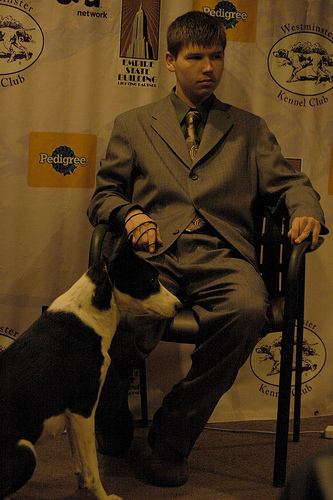Training for heel on lead creates a situation where the handler can completely dominate the dog's behaviour. He can be overbearing and ruthless to the extreme and finish up with a first-class heel worker but a dog of broken spirit. Although few handlers go as far as this, there are degrees of dominance that affect the dog's approach to other and more independent exercises.
Let us consider the handler who has achieved apparent success by the overbearing and ruthless approach to heelwork. A foundation has now been laid for this type of approach. This handler tends to believe that he has mastered his dog and by a domineering method. He reckons that he can continue to train the other exercises in the same manner. If he fails to meet with the success expected, then with each session of failure he reverts to heelwork training to restore absolute control that he has mastered. It is the exercise he can do 'well'. This excessive heelwork training inhibits the handler and dog to the extent that they are incapable of advancing into some of the more independent training exercises. Handler and dog are so conditioned that every move is carried out to restrict commands.
This situation becomes very apparent when some obedience enthusiasts decide to train for or enter working trials. It has been known for a dog to run into a long jump because he is too busy watching his handler. The handler has no idea how to condition the dog to become independent enough to see the jump. Tracking is another occasion that shows up excessive heelwork control. The dog thinks that the tracking line is just a long lead and waits for the commands, instructions, tugs and pulls to tell him he is right or wrong.
As handlers, we can learn a lot more about handling training techniques and self-control if we leave heelwork training until the foundation exercises have been satisfactorily accomplished. The basic ingredient for good heelwork is to have the dog watching your every move and to achieve this you must b prepared to watch his every move. As complete attention is being asked from both you and your dog, the sessions of training should be short. Thirty seconds of heelwork will do much more good than thirty minutes. The initial training for the recall in the foundation group will have created the situation where the dog is prepared to pay attention to you when he knows you are going to start doing training work of some kind.
Loose lead walking is the preliminary step towards heelwork and short spells should be given to achieve this end. The dog is expected to walk at your left-hand side without pulling and has to ignore all distractions. There is no need to start from the customary sit position at this stage - no need even to use the instruction 'heel'. This approach of gaining his attention can be continued by giving him freedom of the lead and if earlier training has been properly carried out he will be watching and waiting for the recall. Do not disappoint him, but when you call him in to you, have him walking at your left side for some five to ten seconds. Remember to use plenty of encouragement and praise. Do not bother about corners, about-turns, or a sit to finish, just have him happily walking at your side. When you can keep his attention in this manner for some ten to fifteen seconds, you are ready to break in more of the heelwork training elements.

 Four Helpful Truths About Blindness in Dogs
If youre reading this theres
Four Helpful Truths About Blindness in Dogs
If youre reading this theres
 Durable Dog Toy Outlasts the Strongest Jaws
Credit: Jeannine T
Durable Dog Toy Outlasts the Strongest Jaws
Credit: Jeannine T
 Heartburn in Dogs
If your dog is anything like
Heartburn in Dogs
If your dog is anything like
 Junior Handler Shows Canaan Dog with Seizure Alert Skill - Westminster 2010
Junior Handler Shows Canaan Dog with Seizure Alert Skill
Junior Handler Shows Canaan Dog with Seizure Alert Skill - Westminster 2010
Junior Handler Shows Canaan Dog with Seizure Alert Skill
 A Dog Breed for Every Occasion
For some dogs, like people,
A Dog Breed for Every Occasion
For some dogs, like people,